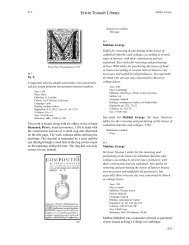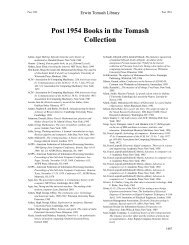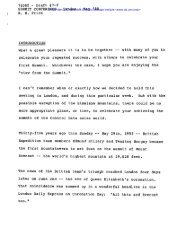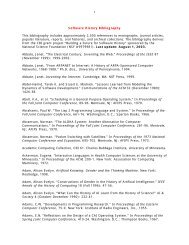B chapter.indd - Charles Babbage Institute - University of Minnesota
B chapter.indd - Charles Babbage Institute - University of Minnesota
B chapter.indd - Charles Babbage Institute - University of Minnesota
Create successful ePaper yourself
Turn your PDF publications into a flip-book with our unique Google optimized e-Paper software.
compass and a sighting device for determining angles <strong>of</strong><br />
elevation. Book 5 contains various pro<strong>of</strong>s <strong>of</strong> geometric<br />
propositions that might be <strong>of</strong> use to a surveyor. The final<br />
book is a discussion <strong>of</strong> how to find square roots and a<br />
table <strong>of</strong> squares for all integers from 1 to 661.<br />
The publisher is <strong>of</strong>ten known as Francesco Franseschi<br />
Sanese because he came from Siena. He is <strong>of</strong>ficially<br />
referred to as Francesco di Franseschi to differentiate<br />
him from Francesco Franceschi (without the di), who is<br />
Lucchese, from Lucca.<br />
118<br />
Illustrations available:<br />
Title page<br />
Portrait<br />
Colophon<br />
Quadrant with shadow scales<br />
Jacob’s Staff<br />
Astrolabe with shadow scales<br />
Quadrant showing origins <strong>of</strong> shadow scales<br />
Tables, page 1<br />
Circumferentor<br />
Erwin Tomash Library<br />
Bartoli, Cosimo Barton, William J.<br />
B 110<br />
Bartoli, Cosimo (1503–1572)<br />
Astrolabe, B 109<br />
Del modo di misurare le distantie, le superficie, i corpi,<br />
le piante, le provincie, le prospettive & tutte le altre<br />
cose terrene, che possono occorrere a gli huomini.<br />
Year: 1589<br />
Place: Venice<br />
Publisher: Francesco di Franceschi<br />
Edition: 2nd<br />
Language: Italian<br />
Figures: 2 folding plates plus many woodcuts in the text<br />
Binding: later vellum<br />
Pagination: ff. 145, [3]<br />
Collation: A–S 8 T 4<br />
Size: 214x153 mm<br />
Reference: Rcdi BMI, Vol. I, p. 90<br />
The second edition <strong>of</strong> this early Italian work on<br />
surveying is, essentially, identical to the first edition <strong>of</strong><br />
1564. Two <strong>of</strong> the large folding plates appear to have been<br />
reengraved, but other illustrations are carried over from<br />
the first edition.<br />
Illustrations available:<br />
Title page<br />
Colophon<br />
B 111<br />
Barton, William J.<br />
B 110<br />
Arithmeticke abreviated. Teaching the art <strong>of</strong> tennes or<br />
decimals to worke all questions in fractions as whole<br />
numbers, without reduction: An easier and plainer way<br />
than the vulgar. Shewing the use also <strong>of</strong> Napiers bones,<br />
by which multiplication and division is performed<br />
without charging the memory at all to those that will<br />
make use <strong>of</strong> them. As also the extracting <strong>of</strong> the square<br />
and cube roots, with divers applications there<strong>of</strong>.<br />
Year: 1634<br />
Place: London<br />
Publisher: James Boler and William Luggard<br />
Edition: 1st<br />
Language: English<br />
Binding: later half morocco over marbled paper boards<br />
Pagination: pp. [8], 140, [2]<br />
Collation: A 4 B–K 8 (- K8 blank)<br />
Size: 140x90 mm<br />
This, published less than twenty years after Napier’s<br />
Rhabdologia (1617), is one <strong>of</strong> the first arithmetics to<br />
explain the use <strong>of</strong> Napier’s rods as a method for facilitating<br />
multiplication, division and extraction <strong>of</strong> roots. Although<br />
translations <strong>of</strong> Napier’s work had quickly appeared in<br />
German (1618), Italian (1623) and Dutch (1626), with<br />
the exception <strong>of</strong> a brief mention in an English almanac <strong>of</strong><br />
1618, the bones had only been described in English once<br />
before in J. Dansie’s A Mathematicall manuel, London,<br />
1627. Barton provides samples <strong>of</strong> Napier’s bones and<br />
instructs his readers to either cut them out or make their







